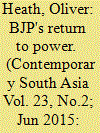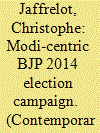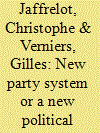|
|
|
Sort Order |
|
|
|
Items / Page
|
|
|
|
|
|
|
| Srl | Item |
| 1 |
ID:
139625


|
|
|
|
|
| Summary/Abstract |
Using constituency-level data, the article examines the BJP's vote swing at the State and Constituency level in India. Drawing on theories of electoral realignment, I examine the BJP's performance at the constituency level and investigate the extent to which the party drew voters from other parties (particularly Congress), mobilised new voters (via increased turnout), and appealed to the newly enfranchised (via increases in the size of the electoral roll). The results of the analysis show that the key to the BJP's success was its ability to mobilise new voters in places where it had previously not fared so well.
|
|
|
|
|
|
|
|
|
|
|
|
|
|
|
|
| 2 |
ID:
094016


|
|
|
|
|
| Publication |
2010.
|
| Summary/Abstract |
The primary question addressed by this essay is: How are religion and religious propaganda in election campaigns in India regulated? I study this question by looking at the rulings of the Supreme Court, which is the final arbiter in all matters related to electoral disputes. The relevant portion of the Representation of the People Act (RPA)-the legislation governing the conduct of Indian elections passed in 1951-that relates to regulating religion are various provisions of Section 123.1 Section 123(3) deems as 'corrupt practice' election candidates or their agents appealing for votes on the grounds of religion or religious symbols; Section 123(2)(a)(ii) defines as corrupt practice attempts to induce a candidate or voter to believe that he would become an object of 'divine displeasure or spiritual censure'; and Section 123(3A) considers as corrupt practice attempts to promote enmity on grounds of religion, race, community or language. More recently, Section 123(3B) does the same for candidates propagating the practice of sati or glorifying it. In addition, Section 125 of the RPA makes attempts to promote enmity or hatred on the 'grounds of religion, race, caste, community or language' a punishable offence.
|
|
|
|
|
|
|
|
|
|
|
|
|
|
|
|
| 3 |
ID:
139627


|
|
|
|
|
| Summary/Abstract |
The 2014 election campaign of the BJP was unprecedented not only because, for the first time, a Chief Minister was the prime ministerial candidate of one of the national parties in the fray and tried to promote his state achievements in terms of development across the nation, but also because the party relied on the personality of its leader more than any other party since the Congress under Indira Gandhi. Narendra Modi broke with the BJP's collegial tradition in several ways. He marginalised party veterans, short circuited the BJP apparatus to use a parallel support structure, and resorted to new techniques of communication that saturated the public space. However, these innovations were superimposed on older themes which had sometimes not been used by the BJP itself before, but by others – like caste politics or corruption. Modi's BJP also fell back on some alliances with other parties, the old RSS network, and revisited Hindutva politics to such an extent that ‘development' was definitely not the only theme of the Modi campaign.
|
|
|
|
|
|
|
|
|
|
|
|
|
|
|
|
| 4 |
ID:
173325


|
|
|
|
|
| Summary/Abstract |
Defying many odds, the BJP has held on to the political space it conquered five years ago and succeeded in expanding its territorial imprint. It did so through a campaign that was substantially different from the 2014 General Election campaign, which was marked by the rejection of the Congress and an enthusiastic embrace of the BJP’s promise of development for all. Five years later, much has changed in India with regard to the political system, which has become more centralized and less liberal. Since the 2019 election, the second Modi-led government has pushed the transition from a de facto Hindu majoritarian state towards a de jure Hindu majoritarian state through the adoption of controversial policies affecting some of the basic normative tenets of India’s old constitutional order, so much so that the BJP’s rise to power has transformed not only the party system, but also the political system itself. This is reflected in India dropping several ranks in most indices of democracy. At the same time, Indian national and state politics have followed divergent paths: the BJP dominates the national stage unchallenged by any rival, but is finding it increasingly difficult to sustain its sway in state elections – leaving the question of the Hindu nationalist hegemony open.
|
|
|
|
|
|
|
|
|
|
|
|
|
|
|
|
|
|
|
|
|